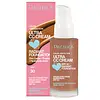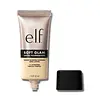Pacifica Ultra CC Cream Radiant Foundation SPF 30 Versus e.l.f. cosmetics Soft Glam Satin Foundation
What's inside
What's inside
 Key Ingredients
Key Ingredients

 Benefits
Benefits

 Concerns
Concerns

 Ingredients Side-by-side
Ingredients Side-by-side

Zinc Oxide 20%
Cosmetic ColorantWater
Skin ConditioningCaprylic/Capric Triglyceride
MaskingAloe Barbadensis Leaf Juice
Skin ConditioningPolyglyceryl-3 Polyricinoleate
EmulsifyingGlycerin
HumectantSimmondsia Chinensis Seed Oil
EmollientHydrogenated Castor Oil
EmollientSorbitan Sesquioleate
EmulsifyingHydrogenated Methyl Abietate
Stearyl/Octyldodecyl Citrate Crosspolymer
HumectantMagnesium Sulfate
Cucumis Sativus Extract
Skin ConditioningMalus Domestica Fruit Cell Culture Extract
Skin ConditioningHelianthus Annuus Seed Oil
EmollientSodium Hyaluronate
HumectantCrithmum Maritimum Extract
Skin ConditioningCrambe Maritima Leaf Extract
Skin ConditioningVitis Vinifera Fruit Cell Extract
Skin ConditioningIsomalt
HumectantLecithin
EmollientTremella Fuciformis Polysaccharide
Emulsion StabilisingDextran
Caprooyl Tetrapeptide-3
Skin ProtectingCopper Tripeptide-1
Skin ConditioningJojoba Esters
EmollientPolyglyceryl-6 Polyricinoleate
EmulsifyingParfum
MaskingCI 77492
Cosmetic ColorantSilica
AbrasiveCaprylhydroxamic Acid
Glyceryl Caprylate
EmollientEthylhexylglycerin
Skin ConditioningXanthan Gum
EmulsifyingSodium Benzoate
MaskingCI 77491
Cosmetic ColorantCI 77499
Cosmetic ColorantZinc Oxide 20%, Water, Caprylic/Capric Triglyceride, Aloe Barbadensis Leaf Juice, Polyglyceryl-3 Polyricinoleate, Glycerin, Simmondsia Chinensis Seed Oil, Hydrogenated Castor Oil, Sorbitan Sesquioleate, Hydrogenated Methyl Abietate, Stearyl/Octyldodecyl Citrate Crosspolymer, Magnesium Sulfate, Cucumis Sativus Extract, Malus Domestica Fruit Cell Culture Extract, Helianthus Annuus Seed Oil, Sodium Hyaluronate, Crithmum Maritimum Extract, Crambe Maritima Leaf Extract, Vitis Vinifera Fruit Cell Extract, Isomalt, Lecithin, Tremella Fuciformis Polysaccharide, Dextran, Caprooyl Tetrapeptide-3, Copper Tripeptide-1, Jojoba Esters, Polyglyceryl-6 Polyricinoleate, Parfum, CI 77492, Silica, Caprylhydroxamic Acid, Glyceryl Caprylate, Ethylhexylglycerin, Xanthan Gum, Sodium Benzoate, CI 77491, CI 77499
Water
Skin ConditioningIsododecane
EmollientGlycerin
HumectantCoco-Caprylate/Caprate
EmollientDimethicone
EmollientPropylene Glycol
HumectantCetyl PEG/PPG-10/1 Dimethicone
EmulsifyingC12-15 Alkyl Benzoate
AntimicrobialTridecyl Trimellitate
EmollientSorbitan Sesquioleate
EmulsifyingSilica
AbrasiveBoron Nitride
AbsorbentDimethicone/Vinyl Dimethicone Crosspolymer
Skin ConditioningMagnesium Stearate
Cosmetic ColorantMagnesium Sulfate
Phenoxyethanol
PreservativeDisteardimonium Hectorite
StabilisingPEG/PPG-15/15 Dimethicone
EmulsifyingTrimethylsiloxysilicate
EmollientDiisostearyl Malate
EmollientSilica Dimethyl Silylate
EmollientAluminum Hydroxide
EmollientTriethoxycaprylylsilane
Caprylyl Glycol
EmollientEthylhexylglycerin
Skin ConditioningErythritol
HumectantHibiscus Esculentus Fruit Extract
Skin ConditioningButylene Glycol
HumectantLycium Chinense Fruit Extract
AntioxidantPsidium Guajava Fruit Extract
AstringentVaccinium Angustifolium Fruit Extract
Skin ProtectingHydroxyacetophenone
AntioxidantCI 77891
Cosmetic ColorantCI 77492
Cosmetic ColorantCI 77491
Cosmetic ColorantCI 77499
Cosmetic ColorantWater, Isododecane, Glycerin, Coco-Caprylate/Caprate, Dimethicone, Propylene Glycol, Cetyl PEG/PPG-10/1 Dimethicone, C12-15 Alkyl Benzoate, Tridecyl Trimellitate, Sorbitan Sesquioleate, Silica, Boron Nitride, Dimethicone/Vinyl Dimethicone Crosspolymer, Magnesium Stearate, Magnesium Sulfate, Phenoxyethanol, Disteardimonium Hectorite, PEG/PPG-15/15 Dimethicone, Trimethylsiloxysilicate, Diisostearyl Malate, Silica Dimethyl Silylate, Aluminum Hydroxide, Triethoxycaprylylsilane, Caprylyl Glycol, Ethylhexylglycerin, Erythritol, Hibiscus Esculentus Fruit Extract, Butylene Glycol, Lycium Chinense Fruit Extract, Psidium Guajava Fruit Extract, Vaccinium Angustifolium Fruit Extract, Hydroxyacetophenone, CI 77891, CI 77492, CI 77491, CI 77499
 Reviews
Reviews

Alternatives
Ingredients Explained
These ingredients are found in both products.
Ingredients higher up in an ingredient list are typically present in a larger amount.
Ci 77491 is also hydrated iron III oxide. It's sole purpose is to give a red/pink hue to products.
Iron III oxides are classified as inorganic chemicals for coloring.
Synthetically created Ci 77491 is considered safer than those naturally found. This is because the synthetically created version may contain less impurities. Iron oxides are generally non-toxic and non-allergenic.
Learn more about CI 77491Ci 77492 is also hydrated iron III oxide. It's sole purpose is to give a yellow hue to products.
Iron III oxides are classified as inorganic chemicals for coloring.
Synthetically created Ci 77492 is considered safer than those naturally found. This is because the synthetically created version may contain less impurities. Iron oxides are generally non-toxic and non-allergenic.
Learn more about CI 77492Ci 77499 is also hydrated iron III oxide. It is created from mixing red and black iron oxides. This helps give shades of darkness to a product.
Iron III oxides are classified as inorganic chemicals for coloring.
Ethylhexylglycerin (we can't pronounce this either) is commonly used as a preservative and skin softener. It is derived from glyceryl.
You might see Ethylhexylglycerin often paired with other preservatives such as phenoxyethanol. Ethylhexylglycerin has been found to increase the effectiveness of these other preservatives.
Glycerin is already naturally found in your skin. It helps moisturize and protect your skin.
A study from 2016 found glycerin to be more effective as a humectant than AHAs and hyaluronic acid.
As a humectant, it helps the skin stay hydrated by pulling moisture to your skin. The low molecular weight of glycerin allows it to pull moisture into the deeper layers of your skin.
Hydrated skin improves your skin barrier; Your skin barrier helps protect against irritants and bacteria.
Glycerin has also been found to have antimicrobial and antiviral properties. Due to these properties, glycerin is often used in wound and burn treatments.
In cosmetics, glycerin is usually derived from plants such as soybean or palm. However, it can also be sourced from animals, such as tallow or animal fat.
This ingredient is organic, colorless, odorless, and non-toxic.
Glycerin is the name for this ingredient in American English. British English uses Glycerol/Glycerine.
Learn more about GlycerinMagnesium Sulfate is a salt. More specifically, it is an epsom salt, or the bath salt used to help relieve muscle aches.
Despite having ‘sulfate’ in the name, it isn’t a surfactant or cleansing agent like sodium lauryl sulfate. Unlike those sulfates, magnesium sulfate doesn’t have the same cleansing or foaming properties (it's simply a type of salt).
In cosmetics, Magnesium Sulfate is used to thicken a product or help dilute other solids. It is a non-reactive and non-irritating ingredient.
One study shows magnesium deficiency may lead to inflammation of the skin. Applying magnesium topically may help reduce inflammation.
You can find this ingredient in sea water or mineral deposits.
Learn more about Magnesium SulfateSilica, also known as silicon dioxide, is a naturally occurring mineral. It is used as a fine, spherical, and porous powder in cosmetics.
Though it has exfoliant properties, the function of silica varies depending on the product.
The unique structure of silica enhances the spreadability and adds smoothness, making it a great texture enhancer.
It is also used as an active carrier, emulsifier, and mattifier due to its ability to absorb excess oil.
In some products, tiny microneedles called spicules are made from silica or hydrolyzed sponge. When you rub them in, they lightly polish away dead skin layers and enhance the penetration of active ingredients.
Learn more about SilicaSorbitan Sesquioleate is derived from sorbitol and oleic acid. It is an emulsifier and prevents ingredients from separating.
Specifically, this ingredient is a water-in-oil emulsifier, meaning it helps water dissolve into oil.
Some studies suggest this ingredient may cause irritation in some people. If you are unsure, it is best to patch test.
This ingredient may not be Malassezia folliculitis, or fungal-acne safe.
Learn more about Sorbitan SesquioleateWater. It's the most common cosmetic ingredient of all. You'll usually see it at the top of ingredient lists, meaning that it makes up the largest part of the product.
So why is it so popular? Water most often acts as a solvent - this means that it helps dissolve other ingredients into the formulation.
You'll also recognize water as that liquid we all need to stay alive. If you see this, drink a glass of water. Stay hydrated!
Learn more about Water